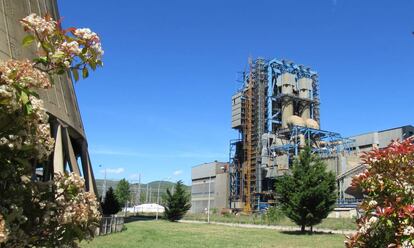With fossil fuel boilers on the way out, heat pumps and green hydrogen jockey for position
Brussels wants all new buildings in the EU to be zero-emissions from 2028

Heating is changing, both in Europe and worldwide. The 2030 Sustainable Development Goals and the Paris Agreement on climate change seek to keep average temperature growth below 2ºC on pre-industrial levels, and as the European Union pursues this objective, the bloc is targeting the decarbonization of all areas of its economy. Among the E.U.’s major focuses is the way we heat our buildings when cold weather hits.
Around the world, heating is responsible for four gigatonnes of CO2 emissions every year, the International Energy Agency says. That’s 10% of all emissions. With this in mind, the E.U. last month reformed its directive on buildings’ energy efficiency, setting its sights on renovating energy-inefficient homes – and eliminating all forms of heating that require fossil fuels. There are two alternatives on the table: heat pumps and renewable hydrogen, also known as ‘green’ hydrogen.
E.U. countries must phase out fossil fuel boilers by 2035
Buildings account for 40% of the E.U.’s energy consumption and 36% of its greenhouse-gas emissions. Heating has a central role to play in that, as 42% of all homes are warmed using natural gas, while 14% use fuel oil and 3% use coal. The European Commission wants all new buildings to be emissions-free from 2028. In addition, the reformed directive will force member states to progressively eliminate fossil fuel boilers by 2035, and to end subsidies for such boilers by 2024. This has opened up a debate on how we should now heat buildings – a debate involving a range of groups: from industry, to government, to environmentalists and the scientific community.
There are two chief proposals: the electrification of heating systems, by using heat pumps to transfer thermal heat; and a hybrid strategy, combining heat pumps with hydrogen-ready boilers that blend the gas – produced using renewable energy – with natural gas.
Hydrogen isn’t a primary source of energy: it can be produced from coal, oil or natural gas, by a process called steam methane reformation (SMR). This, the Hydrogen Science Coalition explains, leads to what is labelled ‘grey’ hydrogen – unless SMR takes place with carbon capture and storage (CCS), in which case the hydrogen is ‘blue’. The production process is highly energy-intensive, so hydrogen without CCS is many times more polluting than simply using coal, oil or natural gas directly. According to data provided by the Hydrogen Science Coalition, around 98% of hydrogen is made using fossil fuels without CCS. ‘Green’ hydrogen, which accounts for only 0.04%, is produced using renewable electric energy, and is made when water molecules are split in a process known as electrolysis, with oxygen the only by-product created.
Against hydrogen
The coalition, which comprises independent scientists and academics, is in favor of decarbonizing heating by means other than hydrogen. David Cebon, a professor of Mechanical Engineering at the University of Cambridge and a member of the organization, explains that the process of producing the gas is inefficient and more expensive – an assessment that other experts we spoke to agree with. “The hydrogen has to be generated from solar or wind energy, perhaps nuclear, and needs six times more renewable energy than heat pumps do,” Cebon says.
He has calculated the energy production necessary to heat every home in Spain using green hydrogen. 146GW of installed wind-energy capacity would be needed to generate the 36GW of renewable electric energy required to produce enough green hydrogen, which in the process of reaching people’s houses would be reduced to 17GW. Meanwhile, the efficiency of heat pumps means that the same amount of energy could be delivered to Spanish homes from only 6.1GW of renewable electric energy, which in turn would be generated from just 25.4GW of installed wind-energy capacity.
Distributing hydrogen throughout the current network of pipes won’t be straightforward, either, Cebon adds. “You can’t use the same pipes,” he says. “In many cases, they’re made of steel and, when in contact with hydrogen, will become brittle and crack.” As a result, he proposes that renewable hydrogen only be used where it is most necessary, such as the plastics and fertilizer industries.
A number of independent scientific studies agree that heating buildings with green hydrogen is inefficient and costly. An analysis carried out by the Regulatory Assistance Project (RAP), which looked at more than 30 such investigations, found that in countries like Spain, the use of this kind of system in 2040 would be between 60% and 120% more expensive than heat pumps in single-family homes, and between 50% and 80% more expensive in multi-family homes.
Need for subsidies
When it comes to heat pumps, RAP’s report notes, their cost, installation challenges and availability make them a less competitive option than fossil fuel heating systems. And it warns that a change of tack will be needed from policymakers: greater information must be provided to consumers and market investment must be guided towards this technology. The study analyses the way in which nations like Sweden have steadily implemented plans aimed at increasing the use of heat pumps. The Scandinavian country has more heat pumps installed per 1,000 inhabitants than any other, according to the platform Better Without Boilers: 105 (compared to three in Spain).
Jan Rosenow, RAP’s director of European programs, believes subsidies are needed as, in most cases, fossil fuel heating systems are cheaper. Rosenow adds that the taxes imposed on electricity, gas and fossil fuels for heating must be adjusted. He also notes that clear regulations are needed on what can be installed from a certain date, and that they must be compatible with climate neutrality efforts, offer certainty to consumers and encourage industry investment.
In Spain, the drive to decarbonize heating has a variety of routes and must adapt to the needs of the country’s homes. Sedigas, an association of Spanish gas companies, supports a range of alternatives depending on the geographical area. “[The heat pump] cannot be the only option,” it says. “The Spanish gas industry has always defended the principle of environmental neutrality and the search for solutions that respond to the specific heating needs of each home, in accordance with its characteristics and uses. The requirements aren’t the same in winter and summer, or in Castile and León [in the north] and on the coast in Murcia [in the south]. Sometimes the heat pump will be the best option; other times it will be district heating or cooling, or equipment using renewable gases, or hybrid technologies such as thermal and photovoltaic solar panels and combustion equipment that allows for the blending of renewable gases.”
The Spanish Hydrogen Association agrees that flexibility is the way forward. “Heat pumps are very efficient and, when the costs of hydrogen solutions drop, that could be very competitive as an energy-providing gas that we can produce and store locally.” Together with Sedigas, the association proposes that green hydrogen be chiefly used in industry and heavy transportation.
Sign up for our weekly newsletter to get more English-language news coverage from EL PAÍS USA Edition
Tu suscripción se está usando en otro dispositivo
¿Quieres añadir otro usuario a tu suscripción?
Si continúas leyendo en este dispositivo, no se podrá leer en el otro.
FlechaTu suscripción se está usando en otro dispositivo y solo puedes acceder a EL PAÍS desde un dispositivo a la vez.
Si quieres compartir tu cuenta, cambia tu suscripción a la modalidad Premium, así podrás añadir otro usuario. Cada uno accederá con su propia cuenta de email, lo que os permitirá personalizar vuestra experiencia en EL PAÍS.
¿Tienes una suscripción de empresa? Accede aquí para contratar más cuentas.
En el caso de no saber quién está usando tu cuenta, te recomendamos cambiar tu contraseña aquí.
Si decides continuar compartiendo tu cuenta, este mensaje se mostrará en tu dispositivo y en el de la otra persona que está usando tu cuenta de forma indefinida, afectando a tu experiencia de lectura. Puedes consultar aquí los términos y condiciones de la suscripción digital.
More information
Últimas noticias
Most viewed
- Sinaloa Cartel war is taking its toll on Los Chapitos
- Oona Chaplin: ‘I told James Cameron that I was living in a treehouse and starting a permaculture project with a friend’
- Reinhard Genzel, Nobel laureate in physics: ‘One-minute videos will never give you the truth’
- Why the price of coffee has skyrocketed: from Brazilian plantations to specialty coffee houses
- Silver prices are going crazy: This is what’s fueling the rally










































